My son and I were scouting along the hedges beside the path leading towards the Orchid Garden at the Singapore Botanic Garden. I first spotted the web of this particular spider and noticed an ugly lump in the middle of the orb web. I guessed it must be a spider which had retracted all its legs tightly against its Cephalothorax and Abdomen. I was right after observing it through my 100mm macro lens. This spider had thin legs. It was perching behind the web instead of above it.
The web probably served as a shield from a spider attacker. As it was hanging, the short and thin legs held close to the major mass of the abdomen would cause less strain on the legs as the strain was in tension rather than compression, so buckling would not occur.
[caption id="" align="alignright" width="240" caption="Kingdom: Animalia Phylum: Arthropoda Class: Arachnida Order: Araneae Family Araneidae Multi-Coloured St Andrew's Cross Spider Argiope versicolor (Doleschall) 1859"]
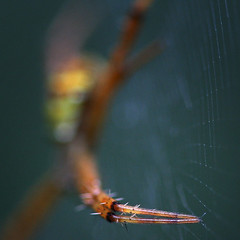 [/caption]
[/caption]This was vastly different from the St. Andrew’s Cross Spiders that have long, sturdy and thick sectioned legs; the legs also work in pairs when they perch right in the middle of their orb web. Their legs were built differently for different purposes. The St. Andrew’s Cross Spiders need sturdy legs to work in compression to support their body mass
I lifted my eyes off the camera viewfinder and spotted a wasp which flew near the Cyclosa and attacked him. It dropped straight down and swung underneath the leaves. It was fast. The wasp flew off, zigzagging vertically, scanning for more Cyclosa.
Next moment, we saw another Cyclosa dropping from above my head. I followed the single silky thread and found him daggling precariously on it. I lifted the thread and tried to place him on a leaf but he was not able to cling on to it. He fell again and hung on the silk thread. I thought I could photograph him and study his injury. As I started photographing him I noticed he could only move his two front legs but not the others and he had fewer legs. The attack by the wasp had been deadly. The venom was kicking in and he was motionless in less than 2 minutes.
We knew that he was bitten but we were not able to see his injury until we reviewed it on the computer. The upper portion of his body was torn apart revealing a huge fresh wound. The wound was fatal. A blob of blood was still visible attached to its silk.
We suspected that the wasp would come back for him and we were right.
[caption id="" align="alignleft" width="333" caption="Kingdom: Animalia Phylum: Arthropoda Class: Arachnida Order: Araneae Subordo: Araneomorphae Superfamilia: Araneoidea Family: Araneidae, Orb-Web Spiders. Island Cyclosa Spider Cyclosa insulana (Costa) 1834"]
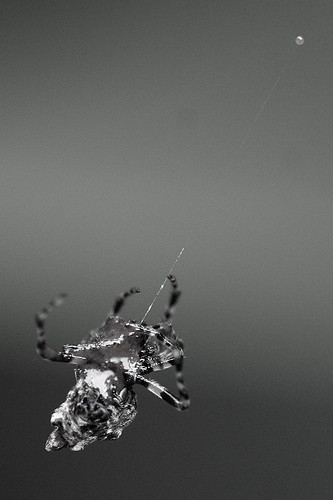 [/caption]
[/caption]The wasp came and started nibbling and tearing the abdomen of the Cyclosa. We watched the wasp hanging and nibbling away at the dead spider. Above this, another wasp was nibbling another Cyclosa in the middle of an orb web, the detail of which was obscured by the limitation of our vision. We only saw movement and more movement lasting about 5 minutes before the wasp flew off. There was so much happening at the same time; we had so much to watch at the same instant. I chose to photograph the wasp nibbling the dead Cyclosa. The sunlight was not that bright and I had to shoot with a huge aperture, which resulted in shallower depth of field; however, I like the cinematographic effects, especially when they are converted into pastel colours.
We watched as the wasp nibbled in mid flight and reduced the Cyclosa’s abdomen to a sheet of mangled skin. The sight was somehow not gross because we could hardly see any bleeding or hear the Cyclosa screaming. It was as if we were watching a silent movie, except it was a rare chance to watch and photograph the wasp in mid flight, exposing its aerodynamics and displaying its anatomy. We were awed and our adrenaline went mad. We had become nature. Nature is oblivious to cruelty and survival was being acted out before us.
[caption id="" align="alignnone" width="552" caption="Kingdom: Animalia Phylum: Arthropoda Class: Insecta Order: Hymenoptera Suborder: Apocrita Superfamily: Vespoidea Family: Vespidae, subfamily Stenogastrinae "]
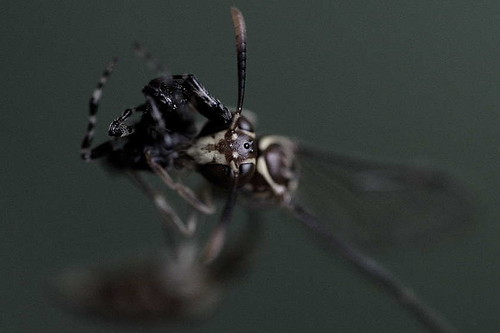 [/caption]
[/caption]At another orb web, we saw a spider scurrying into the middle of the web carrying an injured Cyclosa, which it hid within two folding leaves. He crawled very fast. We suspected that it could be another Cyclosa or possibly they shared a single web - since one was dead, the other might as well have a good feast. However, we were wrong. Through enlargement on our computer we saw that the colour and posture of the predatory spider was not that of a Cyclosa. It was a spider of another species, but with longer legs and it was orange in colour. We could also see that the Cyclosa was tightly wrapped in spider silk. Nature always weeds out the weak and the injured.This was reality. When any animal is injured and weakened, it has to be extra vigilant, and find a safe haven to recuperate; otherwise, death will arrive sooner. As with humans, the powerful also exploit the weak and the ignorant. Only through education can one alleviate poverty and make earth a better place for everyone.
We watched a life perish within that short instant; life is so insignificant and trivial. Like the drop of blood, so tiny and insignificant, except to remind us of that moment of death , pure and complete in its spherical glitter. Life had come full circle.
Another Cyclosa was lucky and survived the assault. He must have been quick to escape. He rolled up into a contracted mass to reduce his exposure to danger. He buried his head like an Ostrich, a form of self-denial, a way to live through this world of Darwinism, the survival of the fittest.
[caption id="" align="alignright" width="333" caption="I found her perching behind the thin web she had spun. She waited patiently for her prey. My lens did not alarm her at all. F.D. Duck commented that this spider looked like an angry spider man with cool green on the belly. "]
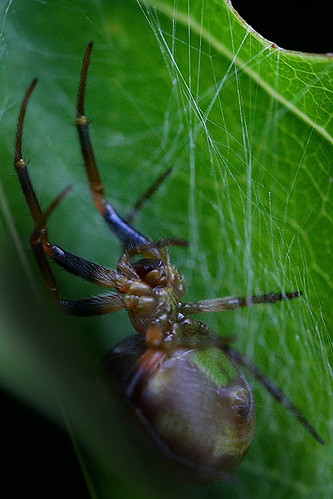 [/caption]
[/caption]The Spider is deemed very scary and creepy due to the many untrue myths associated with it, such as that the Black Widow is the most wicked and deadly or that when a spider lays eggs on a girl’s cheek, they open and spew out hundreds of spiderlings and that the Daddy-longlegs has the world’s most powerful venom but the fangs are too small to bite human beings.
Thanks to Catherine Cook she had kindly help me corrected my atrocious grammar, something I always get it wrong. So this is a revised version.
Yes she also commented that the ending is kind of delinked from the main article, I will need some time to look into that.
Thanks vespa_bicolor too for IDing the wasp
vespa_bicolor says:
Family Vespidae, subfamily Stenogastrinae. Stenogastrine wasps are commonly known as hover wasps due to their soundless, hovering flight. They are among the most primitive of social wasps and are quite specialised for both stealing prey from spiders' webs and sometimes attacking the spider itself, as you have witnessed. Please visit my website for more info: www.vespa-bicolor.net
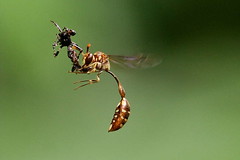
Excellent pictures!! The detailed description on what, when, where and how were truly amazing!! Great site!!
ReplyDeleteMeng Foo,
ReplyDeleteIt would sure make a great national geographic article, why don't you try sending it them? From the section on the spiders' legs structure, you are one of the few architects I know who got a good sense of strutural behaviour.
Here's wishing you health and happiness in the new year!
Boon Kok
Thanks for giving me your valuable comment. I hope to share what I had learned from observing the insects and spider. There is so much first hand knowledge from observing nature. It was a very calming and peaceful, though at times adrenaline pumping, learning process.
ReplyDeleteMeng Foo,
ReplyDeleteThrough your pictures, it is as clear as daylight that you are not only an architect but also an artist and biologist all rolled into one - the convergence of art and science......
I especially enjoy your Animalia Phylum picture which has an amazing tone.
It is great that you enjoy the photographs. I hope to write more. Thanks
ReplyDeleteA great job!
ReplyDeleteGreat article you've written. Very vivid and captivating, almost as if I'm there myself witnessing these amazing acts of nature.
ReplyDeleteI also liked the manner in which you weaved in couple of "life lessons" as well. Great photography !
@wee meng
ReplyDeleteGreat that you came by and took a look. Your comment is very encouraging. I had just bought a robotic arm to create huge gigabyte images. Will upload when I am ready.
very interesting pictures and information for nature lover.
ReplyDeleteHi! I was surfing and found your blog post... nice! I love your blog. :) Cheers! Sandra. R.
ReplyDeleteThanks. This picture was once in a life time chance. I had never seen another, for 5 years already.
ReplyDeleteI do agree with all of the concepts you've introduced on your post. They're very convincing and will definitely work.
ReplyDeleteNonetheless, the posts are too short for novices. May you please extend them a bit from subsequent time?
Thank you for the post.